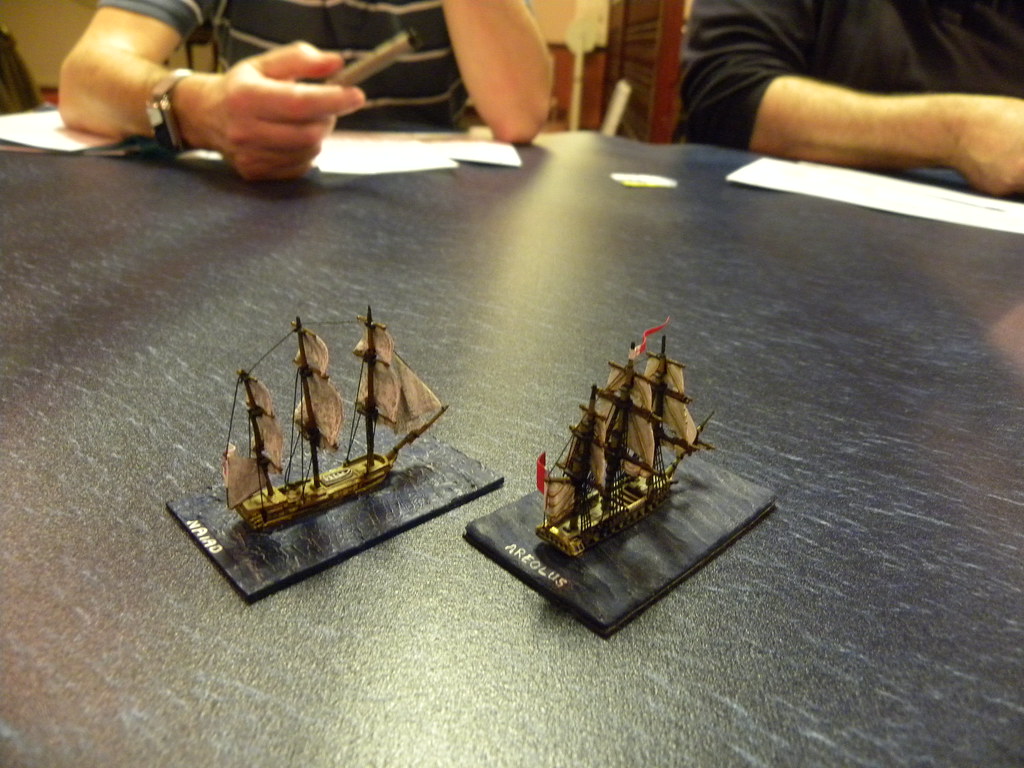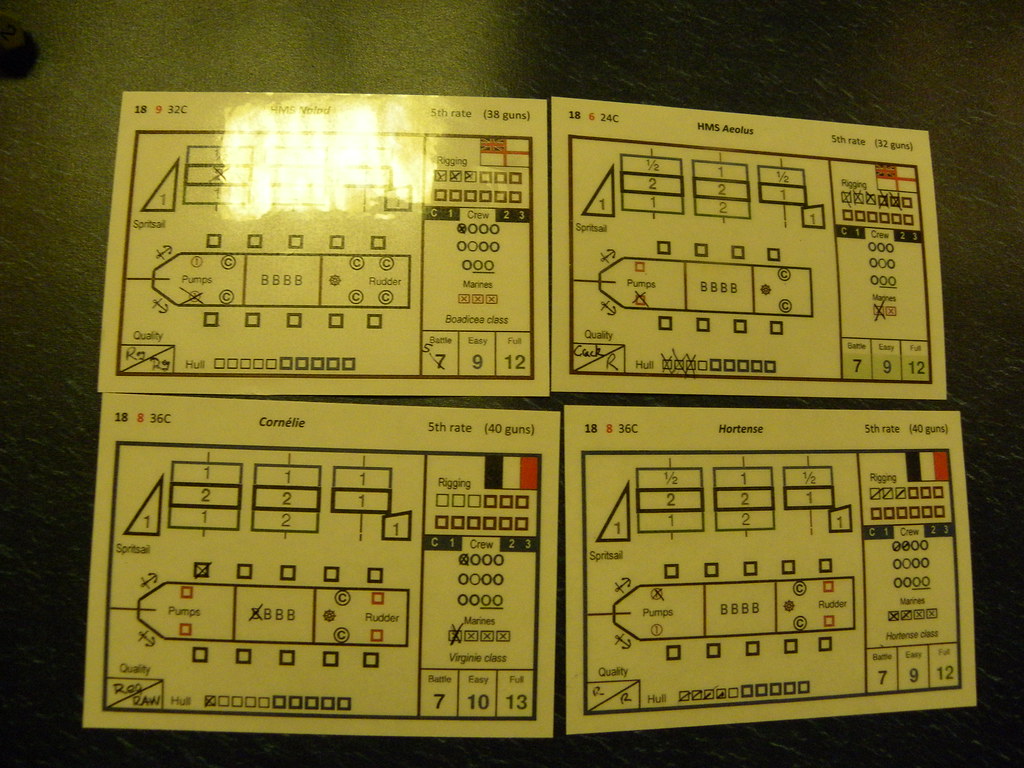Today, the game we had yesterday. Angus proposed the rules, he got from some time and had never played them before. That was the another product from General Quarters, this time for actions in Napoleonic period called Post Captain. Rules are written by L.L. Gill and M.R. Baulch. First I have to said that the try to read them was a huge nightmare for me. It seems to be very complicated set of rules, the extensive ship cards and the large number of stuff used during the game and also different measurements etc. It from the first look scared most of the wargamers in our club, so they decided to stay away of them. However we decided to give it a go and it proved how much I was wrong!
Dzisiaj gra, którą rozegraliśmy wczoraj. Angus zaproponował nam zasady, które posiadał już od jakiegoś czasu, jednak nigdy nie miał szansy w nie zagrać. Był to kolejny produkt od General Quarters, tym razem przeznaczony do rozgrywania potyczek w czasach napoleońskich zwany Post Captain. Zasady zostały napisane przez L.L. Gilla i M.R. Baulcha. Wpierw muszę powiedzieć, że próbowałem je przeczytać i przyswoić, jednak okazało się to zbyt dużym wyzwaniem dla mnie. Wydawały się zbyt skomplikowane, ze zbyt rozbudowanymi kartami okrętów i dużą ilością pomocy do gry przestraszyła wielu graczy w naszym klubie, więc zdecydowali się trzymać od nich z daleka. Jednakże zdecydowaliśmy się dać im szansę i to udowodniło jak bardzo się myliłem!
SCENARIO/SCENARIUSZ: Angus Konstam
UMPIRING/PROWADZENIE GRY: Angus Konstam
SCENERY/SCENERIA: SESWC
MODELS/MODELE: Angus Konstam, Jack Glanville, Bartek Żynda
1. Forces. Siły.
ROYAL NAVY
HMS Naiad (38 guns) - Angus
HMS Aeolus (32 guns) - Peter
MARINE NATIONALE
Hortense (40 guns) - Campbell
Cornelie (40 guns) - myself
2. The game. Gra.
The first good reason to play that game, was possibility to use of my little Cornelie. That French frigate never been used before, so that was her debut. Before the game, we all decided that our ships will be moving only under battle sails and without boarding or ramming actions to made the game as much simple as it could. For some first phases of the game we had to get familiar with the rules, but with time, the game became very friendly for us. All stuff used during the game proved to be very useful. The ship's cards proved to be very simple and well designed. All my pregame worries were unnecessary. However more about the rules I will post another time. Before the game we had roll for our crews and captains. All our commanders were regular and most of the crews too besides of mine, which I rolled very badly and my boys were very raw. The quality of my troops meant that all things they did longer and worst than the other crews. That determined my tactic for the game: to get very close to the opponent, fired all of my guns and move away to reload my guns. In that rules the turn has 5 phases.Three of them are called white, red and blue when you are shooting, sailing, and reloading your guns. Another two are the command phases for command test and repair tests. British crews reload their guns in two turns, so if they lucky, they can shoot twice during the turn, French crews need three phases to reload the guns and my, because of its quality needed 4 phases, so I was able to shoot once on two turns. A huge disadvantage. That brings me most of the game away from main actions. Most of fight had to be taken by Campbell, who bravely stood against two british ships. The lack of time forced us to finish the game without any results. Both British ships were lightly damaged and Hortense had some serious problems, but my ships had only some scratches. That gave us a draw and sure, that we will use that rules again.
Pierwszym dobrym powodem by zagrać w tą grę, była możliwość użycia mojej małej francuskiej fregaty Cornelie. Jakoś nigdy nie miałem możliwości jej użycia, więc był to jej debiut. Przed grą zdecydowaliśmy się na kilka uproszczeń: okręty poruszały się na żaglach bojowych i nie można było dokonywać abordażu ani taranować wrogich okrętów. Przez kilka pierwszych faz gry zapoznawaliśmy się z zasadami, ale z czasem gra stawała się coraz bardziej łatwa. Wszystkie dodatkowe rzeczy używane w grze okazały się bardzo pomocne, karty okrętów bardzo czytelne i proste a wszelkie moje przed growe wątpliwości niepotrzebne. Jednak więcej na temat samych zasad napisze innym razem. Przed grą, każdy z nas musiał rzucić na jakość naszych kapitanów i załóg. Wszyscy kapitanowie i prawie wszystkie załogi, oprócz mojej okazały się być regularne. Moi ludzie okazali się być słabo wyszkoleni. To zdeterminowało moją taktykę na całą grę: zbliżyć się do okrętów przeciwnika, oddać strzał i szybko się oddalić by przeładować działa. W tych zasadach tura dzieli się na pięć faz. Trzy z nich są zwane fazą białą, czerwoną i niebieską. Podczas tych faz można okręty poruszać, strzelać bądź przeładowywać swoje działa. Następne dwie tury są na testy, pierwsza na naprawy i druga dowodzenia. Brytyjskie załogi przeładowywują swoje działa w ciągu dwóch faz, więc jeśli szczęście im dopisze mogą strzelać dwa razy na turę, Francuzi przeładowywują działa w trzy tury i moja świeża załoga, potrzebowała aż czterech faz by przeładować działa, co dawało mi możliwość oddania strzału raz na dwie tury. Olbrzymie utrudnienie. To spowodowało, że większość gry, mój okręt trzymał się z dala od głównej akcji. Cały ciężar walki musiał więc wziąć na siebie Campbell, który dzielnie stawał przeciw dwóm brytyjskim okrętom. Brak czasu zmusił nas do zakończenia gry bez wyraźnego rezultatu. Oba brytyjskie okręty były lekko uszkodzone a Hortense miała jakieś poważne problemy, natomiast mój okręt miał tylko kilka zadrapań. To dało nam remis i pewność, że te zasady wypróbujemy na pewno jeszcze raz.
3. Links. Linki.
Angus:
Campbell (SESWC):
to be updated...
Flickr:





Sounds great!
OdpowiedzUsuńAnd it is great!
UsuńVery nice looking ships!
OdpowiedzUsuńThank you.
UsuńOkręty wyglądają niesamowicie!
OdpowiedzUsuńDziękuje.
UsuńNie znam gry kompletnie, ale rozgrywka wygląda niesamowicie.
OdpowiedzUsuńGra jest ok, polecam się zapoznać i nie zniechęcać się na zapas po przeczytaniu zasad. Cieszę się, że się podoba.
Usuń